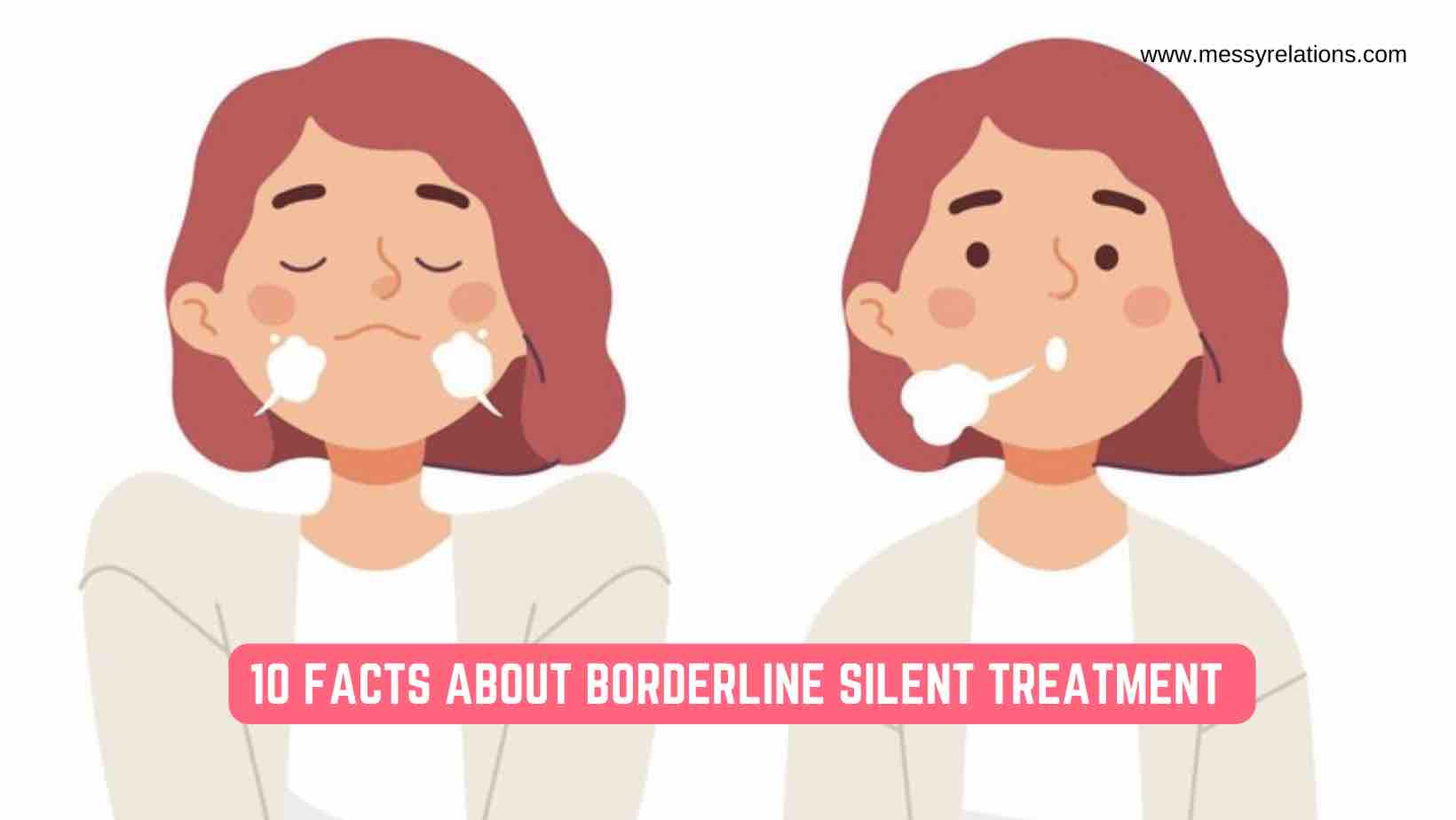The borderline silent treatment, a behavior often observed in individuals with Borderline Personality Disorder (BPD), can be a perplexing and challenging experience for both the individuals and their loved ones. This article aims to shed light on this complex phenomenon, presenting 10 vital facts that everyone should know. Whether you’re personally dealing with BPD, supporting someone who is, or simply seeking to broaden your understanding, these insights into the borderline silent treatment will provide clarity and knowledge.
1. It’s A Form of Emotional Expression
The first key fact about the borderline silent treatment is that it’s often used as a form of emotional expression. Individuals with BPD may struggle with articulating their feelings verbally and thus resort to silence as a way to communicate distress, anger, or disappointment. This behavior is not necessarily manipulative but can be a coping mechanism for overwhelming emotions. Understanding this can help in approaching the situation with empathy, recognizing that the silence might be an expression of emotions that the individual finds challenging to convey in words.
2. It’s Usually A Response to Perceived Threats
Individuals giving the borderline silent treatment often do so in response to perceived threats to their emotional stability or identity. These threats can include fear of abandonment, rejection, or feeling misunderstood. For someone with BPD, these perceived threats can trigger intense emotional reactions, and silence becomes a defense mechanism. Recognizing this trigger can be crucial in addressing the root cause of the silent treatment.
3. It’s Not Always Intentional
It’s important to note that the borderline silent treatment is not always a conscious or intentional act. Individuals with BPD may retreat into silence subconsciously when they feel emotionally overwhelmed or unable to cope. This distinction is vital in understanding the behavior’s nature and in preventing the attribution of malice where there is none.
4. It Can Cause Relationship Strain
The borderline silent treatment can strain relationships significantly. Partners, family members, and friends may feel shut out, frustrated, or helpless. It’s crucial for loved ones to understand that this behavior is part of a complex mental health condition and not a reflection of their worth or actions. Open communication about the impact of this behavior can help in finding mutually beneficial ways to cope.
5. It is Basically A Need for Professional Help
Addressing the borderline silent treatment effectively often requires professional help. Therapy, especially dialectical behavior therapy (DBT), can be beneficial for individuals with BPD. DBT focuses on building skills in emotional regulation, interpersonal effectiveness, and distress tolerance, which can help reduce the frequency and intensity of the silent treatment.
6. It is Linked to Fear of Abandonment
One of the core characteristics of BPD is the fear of abandonment, which can be a driving force behind the borderline silent treatment. The individual might use silence as a way to protect themselves from the perceived threat of being left or hurt. Understanding this fear can provide context to the behavior and guide the approach in addressing it.
7. It’s Usually A Cry for Help
In some cases, the borderline silent treatment can be a non-verbal cry for help or attention. It may indicate that the individual is going through a particularly tough time and doesn’t know how to ask for support. Recognizing this can be a step towards providing the needed help and understanding.
8. It has Impact on Mental Health
The borderline silent treatment not only affects relationships but also the mental health of the individual practicing it. This behavior can lead to feelings of guilt, loneliness, and increased emotional turmoil. It’s important for individuals with BPD to be aware of this impact and seek appropriate coping mechanisms and support.
9. Importance of Self-Care for Loved Ones
For those on the receiving end of the borderline silent treatment, self-care is crucial. It can be emotionally taxing to deal with this behavior, so maintaining your mental health and seeking support is important. Engaging in activities that bring joy, talking to friends or a therapist, and setting boundaries can be helpful in managing the emotional toll.
10. Opportunity for Personal Growth
Lastly, navigating the complexities of the borderline silent treatment can lead to personal growth for both parties. For individuals with BPD, learning to express emotions in healthier ways can be empowering. For their loved ones, this experience can deepen understanding, patience, and communication skills.
The borderline silent treatment is a multifaceted behavior rooted in emotional complexities. Remember, dealing with BPD and its manifestations like the borderline silent treatment requires patience, understanding, and often professional guidance. Through this understanding, there can be growth, better communication, and stronger relationships.
How to Deal with Borderline Silent Treatment?
Dealing with borderline silent treatment can be a perplexing and emotionally taxing experience. This behavior, often observed in individuals with Borderline Personality Disorder (BPD), involves a deliberate withdrawal from communication and interaction, typically in response to emotional distress or perceived threats. Whether you’re experiencing this in a personal relationship or supporting someone who is, understanding how to deal with the borderline silent treatment is crucial for maintaining healthy interactions and emotional well-being.
Understand the Behavior First
Before delving into how to deal with the borderline silent treatment, it’s important to understand its roots. Individuals with BPD often experience intense emotions and fear of abandonment, which can lead to using silence as a coping mechanism. This behavior is not necessarily intended to manipulate or punish, but rather to protect themselves from perceived emotional harm. Recognizing that the borderline silent treatment is a response to internal distress, rather than a personal attack, is key in addressing it effectively.
1. Communicate Openly
Effective communication is essential in dealing with the borderline silent treatment. Approach the individual calmly and express your concern and willingness to understand their feelings. Use “I” statements to convey how their silence affects you, without placing blame. For instance, say, “I feel worried when I don’t hear from you.” This opens up a space for dialogue and shows that you are approachable and empathetic. Remember, the goal is to encourage open communication, not to force it, so be patient and give them time to open up.
2. Set Necessary Boundaries
While empathy is important in dealing with the borderline silent treatment, setting clear boundaries is equally vital. Communicate your limits regarding what behaviors you can accept and how the silent treatment affects you. Setting boundaries might involve stating that while you understand their need for space, complete withdrawal from communication is challenging for you. Emphasize that you are willing to give them space, but also need open lines of communication for a healthy relationship. It’s crucial that these boundaries are set respectfully and kindly, reinforcing that they are meant for the well-being of both parties involved.
3. Encourage Professional Support
Encouraging the individual to seek professional support can be beneficial in dealing with the borderline silent treatment. Therapy, particularly Dialectical Behavior Therapy (DBT), can be effective for those with BPD. DBT focuses on skills like emotional regulation and interpersonal effectiveness, which can help reduce reliance on the silent treatment as a coping mechanism. Suggesting therapy should be done delicately and supportively, making it clear that the recommendation comes from a place of care and a desire to improve the relationship.
4. Practicing Self-Care Is Important
Dealing with the borderline silent treatment can be emotionally draining. It’s essential to practice self-care to maintain your mental and emotional health. Engage in activities that you enjoy and that relax you, connect with friends and family for support, and consider seeking your own therapy or joining support groups. Taking care of your well-being enables you to approach the situation with more patience and understanding, and prevents you from becoming emotionally overwhelmed.
5. Maintain Patience
Patience is a key component in dealing with the borderline silent treatment. Understand that change takes time, especially for individuals with BPD who are working through complex emotional issues. Avoid pressuring them to communicate and give them the time they need to feel comfortable opening up. Patience also involves recognizing that there may be setbacks and that progress might be slow. Keeping a patient and understanding attitude can create a more supportive environment for both you and the individual with BPD.
6. Seek More Understanding
Efforts to understand the reasons behind the borderline silent treatment can improve how you deal with it. Educate yourself about BPD and its challenges, and try to see the situation from the perspective of the person with BPD. Understanding their fears, triggers, and emotional struggles can help you respond more empathetically and effectively. This doesn’t mean excusing harmful behavior, but rather having a deeper comprehension of the factors contributing to the silent treatment.
7. Avoid Retaliation
It’s important not to retaliate with your own silent treatment or punitive measures when dealing with someone exhibiting borderline silent treatment. Retaliation can escalate the situation and deepen the communication gap. Instead, remain calm and approach the situation with a mindset of resolving it. Showing that you are willing to maintain open and non-confrontational communication, even when it’s challenging, sets a positive example and can encourage them to do the same.
Dealing with borderline silent treatment requires a balanced approach of understanding, communication, boundary-setting, and self-care. It’s about navigating the complexities of BPD with empathy while also ensuring your emotional needs are met. Patience, education, and avoiding retaliation are key in fostering a healthier dynamic. Remember, while you can offer support and understanding, professional help is often necessary for lasting change. Dealing with borderline silent treatment is challenging, but with the right approach, it can lead to growth and stronger relationships.
Disclaimer: This article is for informational purposes only and is not a substitute for professional medical advice, diagnosis, or treatment. Always seek the advice of your physician or other qualified health provider with any questions you may have regarding a medical condition.
Remember we are sharing information based on our experiences but there is no medical backing involved. We intend to share the information we have gathered through internet research or personal experiences. We would recommend you to verify all the facts with professional experts if you need help. Always seek professional help if you are facing difficulties with regard to the issues listed above.


